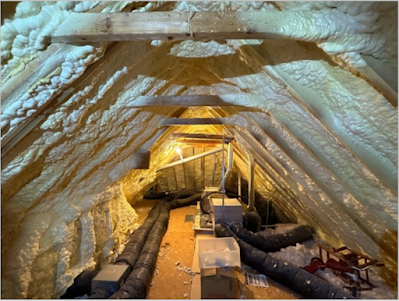If your attic looks like this from original construction, or as a retrofit, and you are unable to verify a means of moisture control installed during original construction or as part of the retrofit you may be experiencing a nightmare you are not aware is occurring. Your roof may now or soon be looking like this with wet, moisture damaged roof sheathing and not be leaking.
The worst enemy of our homes is water in all of its forms liquid, solid (ice), and vapor leading to damage, mold and rot. Water intrusion can come from many sources the most obvious of which is leaking storm water and leaking plumbing. In our area we do not experience a great deal of ice and snow but that again is a obvious issue. What isn't as obvious is vapor and condensation of that vapor of cooler surfaces. Vapor is produced by our everyday life and actions in our homes. The very act of breathing, by every person and pet, in our homes produces vapor. Then there is vapor formed every time we run hot water, in our sinks, tubs, showers, washing machines, dishwashers and cook. Release of water vapor is part of the process of every load of clothes we dry in our dryers. Those dryer vents to the exterior are about much more than heat and lent. They are about directing damaging moisture/vapor out of our homes. Bath roof and kitchen ventilation is about the same not about odors. Water vapor rising from our crawlspaces migrates to our attics. Odors don't damage, water vapor does.
Now that we have identified water vapor as an enemy of our homes what does this have to do with our attics and foam insulation in our rafters. Most attics are ventilated using soffit, ridge, gable vents and power ventilators. Our first thought is about removing heat and that is important however, this ventilation is also about removing water vapor rising from us living in our homes. For attic rafter attic spray foam insulation to be effect in its purpose of insulation of our home the ventilation using outside air must be sealed off. This action traps moisture vapor in our attics. This vapor rises, migrates through the insulation to the roof sheathing, condensates, to its liquid form, leading to wet roof sheathing, buckling of the sheathing (as observed in the photo above) rot and ultimate failure. Someone walking on the roof may literally fall through.
The home where these photos were made had an additional worse situation. Below the high attic was a vaulted ceiling with fiberglass bat insulation. This is the area of the photo of visible buckled roof sheathing above. When you install a finished ceiling on the underside of roof rafters, on a vaulted ceiling, that rafter space MUST have ventilation to allow moisture vapor and heat to escape. In this situation that was baffles below the roof sheathing to allow for air movement, soffit vents and the on the high side it vented into the attic space above escaping through the standard attic ventilation systems. Not only did the foam insulation contractor fail to provide a means of moisture control in this attic after installing the foam insulation, he foamed the top of the vaulted ceiling rafters where the air was flowing from the soffit vents through the rafter space in to this attic. The first nightmare was bad enough leading to vapor condensing to liquid water on the underside of the roof sheathing but this additional entrapment of the air flow lead to that moisture vapor having no where to go leading to this area of roof sheathing deteriorating much faster than the rest.
What makes this a nightmare is that once you begin to observe the issues it causes it is too late to correct the moisture control issue as the damage is likely already extensive. Repair involves providing a means of moisture control which can be ventilation from conditioned spaces, conditioning the attic space with air from the heating and air conditioning system, providing a separate system, a dehumidifier or an air to air heat exchanger ventilating the attic space with conditioned are from the exterior as it removes damp air. If you image all of this sounds very expensive, you have no clue.
I suggest if you have foam insulation installed in the attic rafters of your home, whether original or retrofit, and you can't verify there is a proper means to remove moisture you need to contact us and book a complete home inspection immediately to determine potential issues. Why a complete inspection? If this is the case in your home, as with this home, it will not likely be the only issues we discover.
Book your inspection NOW at www.blackcatinspectionservices.com
Photo credit to our inspector Josh Hedges.


No comments:
Post a Comment